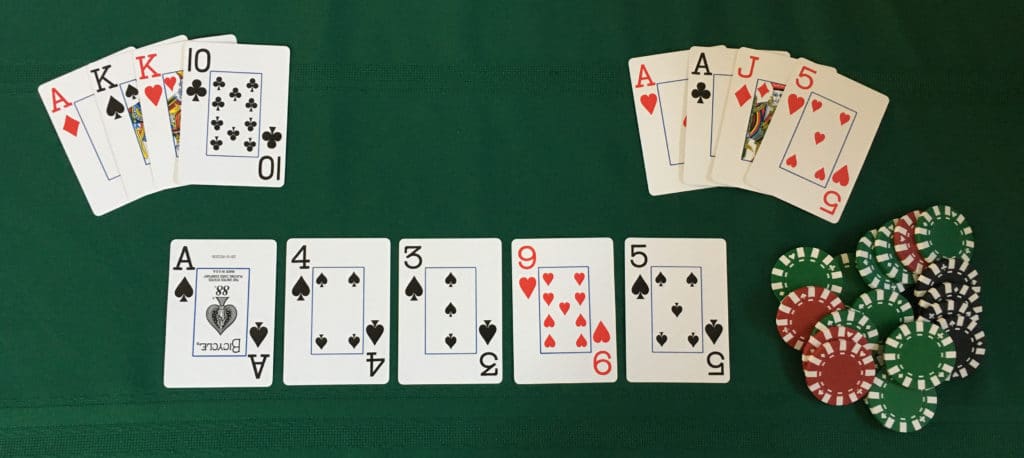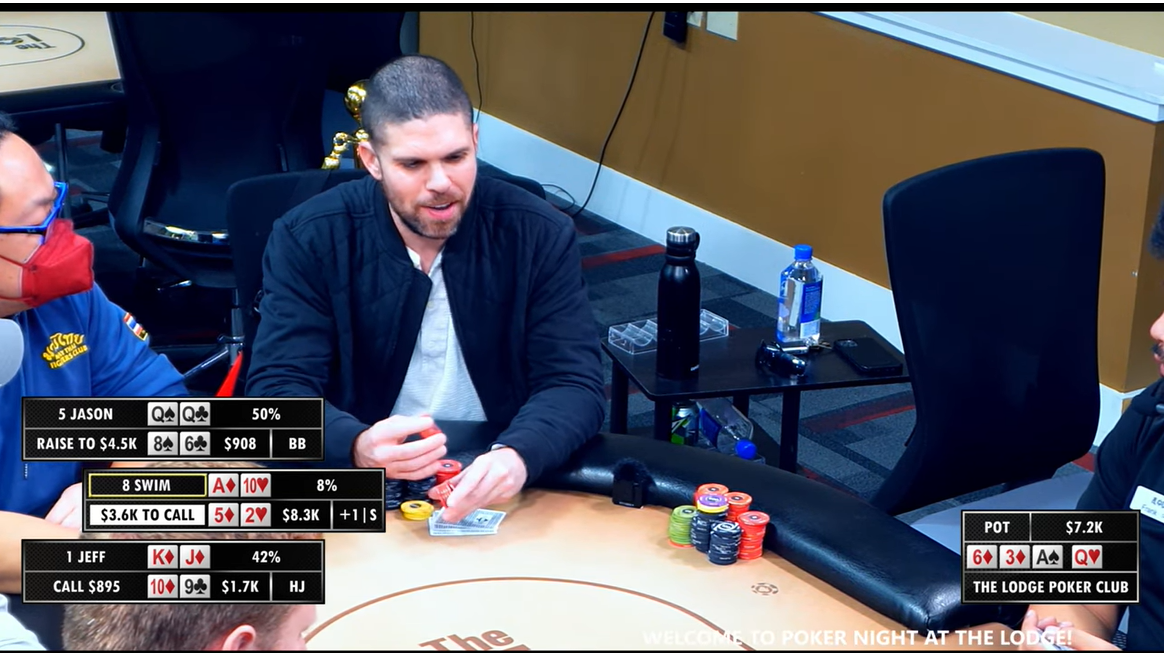Pot-Limit Omaha is one of the world’s most popular poker variants. Also commonly known as PLO, Pot-Limit Omaha trails only No-Limit Texas Hold’em as the most-played poker game. Pot Limit Omaha poker rules are similar to Hold’em, but with some key differences.
After a recent surge in popularity, PLO is more popular than ever in poker rooms around the globe. Pot-Limit Omaha stands as the centerpiece of some of the most action-packed games that run at the Lodge.
Even if you come to the Lodge to play No-Limit Hold’em, you’ll want to become familiar with Pot-Limit Omaha. Here’s a look at the rules of PLO:
Pot-Limit Omaha Poker Rules
PLO plays similarly to No-Limit Hold’em, with two significant exceptions.
All players receive four hole cards face down in a hand of PLO. Pot-Limit Omaha is a community card game, with five community cards dealt to the board in rounds known as the flop, the turn, and the river.
If you’re familiar with Texas Hold’em, you already know how a community card poker game functions. In Texas Hold’em, you can use any combination of hole cards and community cards to make the best five-card hand.
According to Omaha poker rules, however, you must use exactly two hole cards combined with three community board cards, with the task of making the best possible hand according to standard poker hand rankings. The requirement to use exactly two hole cards can lead to tricky situations for newcomers to the game.

The other major difference between PLO and No-Limit Hold’em is that PLO uses a pot-limit betting structure. In No-Limit Hold’em, you can go all-in at any time, betting all of your chips.
In PLO, however, the maximum possible bet or raise is equal to the size of the pot. Calculating the size of the pot (and therefore your maximum possible raise) is sometimes more complicated than you might think.
PLO is just one version of Omaha. PLO is sometimes known as Omaha High, but not all Omaha High games are played with a pot-limit betting structure.
How To Calculate The Pot In PLO
Pot-limit betting rules can apply to many different poker variants. PLO is, by far, the most popular poker game that uses a pot-limit betting structure.
In PLO, or any pot-limit game, the maximum bet allowed is equal to the size of the pot. Calculating the size of the pot can be simple at times, particularly in preflop scenarios where you’re the first player to act.
After the first round of betting, however, calculating a pot-sized bet can become tricky.
Under pot-limit rules, a pot-sized bet is equal to the size of the pot, plus any outstanding bets, plus the amount you’d have to put in to call the last outstanding bet.
You can take somewhat of a shortcut in calculating the pot with the “multiply by three” rule. Using that guideline, you calculate the size of the pot before the latest bet. Then, take the latest bet or raise, multiply it by three, and add it to the amount already in the pot. This gives you the maximum amount you can bet.
Let’s look at calculating the pot, both preflop and postflop:
Calculating The Pot Preflop
Let’s say you’re playing in the $1/$2 PLO game at the Lodge. You’re under the gun (UTG) and first to act preflop. How much can you bet?
In this case, the size of the pot is $3. We treat the $2 amount of the big blind as the last outstanding bet. You would have to put in $2 to call the big blind.
These are the three numbers needed to figure out a pot-sized bet. In this case, you would add $3 (the size of the pot), $2 (the last outstanding bet), and $2 (the amount you need to call the previous bet.
That equation ($3+$2+2) gives us $7. If you’re first to act preflop in a $1/$2 PLO game, you can raise to $7.
Suppose the action folds to the button; how much can that player bet? The size of the pot is $10, the last outstanding bet is $7, and you would have to call $7 to match the previous bet.
We once again use our pot-limit equation, adding ($10+$7+$7), which equals $24. The button player can raise to $24 total.

Let’s try the “multiply by three rule” for the button player. We take the amount in the pot before the latest bet, which was $3. The under-the-gun player bet $7, so we multiply that by three and add to the size of the pot before that bet.
That works out to ($3+$21), which comes out to the correct amount of $24.
Any time a player bets or raises under pot-limit rules, all remaining players must consider the last outstanding bet when calculating the size of the pot.
Calculating The Pot Postflop
Continuing with our previous hand example, suppose UTG opens to $7, the button raises to $24, both blinds fold, and UTG calls. We go to the flop with $51 in the pot (the $1 small blind, $2 big blind, and $24 each from UTG and the button).
If you’re the UTG player and want to lead out with a bet on the flop, how much can you bet? As the first-to-act player in any postflop round, you’re maximum allowed bet is equal to the current size of the pot. A pot bet is $51 in this case.
If you bet $51, how much can the button player raise to? The pot is now $102, the previous bet is $51, and the amount to call is $51.
The pot-limit equation gives us ($102+$51+$51)=$204. The button can raise to a maximum of $204 total.
Let’s try the multiply by three rule in this scenario. The amount of the pot before the latest bet was $51. The amount of the latest bet was $51, so we multiply that by three ($51*3)=$153. We then add that to the pot size before the latest bet ($153+51)=$204.
Getting Help With Calculating The Pot
The ability to calculate a pot-sized bet is crucial to PLO strategy. Luckily, the dealers at the Lodge are able to help with that.
Any time you want to bet the pot in a live PLO game, just declare “pot” and the dealer will calculate the bet for you. This applies to live poker games at the Lodge or any casino. In online poker, just click the pot-raise button to bet pot.
At the Lodge and other live poker rooms, saying “pot” commits you to a pot-sized bet. If you want to ask the dealer how much a pot bet is at a given time, ask “how much is the pot” or something similar.
Asking the question in that manner will prompt the dealer to calculate the pot for you, without committing you to the bet.
How To Play Omaha Poker
PLO Example Hand
Now let’s take a deep dive into Omaha poker rules and run through an example PLO hand from start to finish,
PLO hands begin much like Texas Hold’em poker hands. Starting with the player to the left of the dealer button, the dealer deals four cards to each player, face down.
When all players have their cards, the preflop betting round begins. Beginning with the player to the left of the big blind, all players get the opportunity to either call (match the amount of the last outstanding bet), raise (increase the amount of the last bet, up to the max of a pot-sized bet), or fold (surrender their cards and drop out of the hand.)
Preflop Betting Round
Using our example from above, let’s say you’re the player that starts the preflop round. You’re in the position known as “under the gun” (UTG), you have $1,000 in front of you, and you look down at:
Your Hand: A♣Q♣7♦4♦
From UTG, you open the action with a $7 bet, the size of the pot. All players behind you fold until the action gets to the player on the button (the position to the immediate left of the small blind).
The button player (who also starts the hand with $1,000) raises pot, which is a $24 bet. The small blind folds, the big blind folds, and the action is back on you in the UTG position.
At this point, you could either call (match the $24 bet), raise (to a maximum of $82 by pot-limit rules), or fold, ending the hand.
You choose to call. The pot is $51 and the hand goes to the flop, with you and your opponent both having $976 left.
Flop Betting Round
On the flop and all subsequent betting rounds, the player in the small blind begins the action if they’re still in the hand. If not, the next live player to the left of the small blind starts the action.
The dealers deals the flop, putting out the first three of five community cards and the second round of betting begins:
Flop: A♥A♠J♠
Your Hand: A♣Q♣7♦4♦
In the UTG position, you start the flop betting round. You can either check (bet nothing and pass the action to the next player), or bet, up to a maximum of $51.
You choose to check, and the button bets $35. You can either call (match the $35) raise (to a max of $156), or fold.
You choose to raise pot, making it $156 to go. Your opponent on the button can either call the $156, raise pot again, or fold. A pot raise in this scenario would be to $554 total.
Your opponent calls, and the pot is $363 going to the next betting round. Both you and the button have $820 left.
Turn Betting Round
The dealer deals the fourth community card. This card, known as the turn (or fourth street) leaves the board looking like this:
Board on the Turn: A♥A♠J♠4♣
Your Hand: A♣Q♣7♦4♦
Remember, the object of PLO is to make the best five-card poker hand possible by any combination of exactly two hole cards and three community cards.
The 4♣ gives you a full house, aces full of fours. You check the turn, and your opponent checks back.
Neither you or your opponent added any money to the pot on the turn, and the pot is still $363 going to the river.
River Betting Round
The dealer puts out the river card, and the final round of betting commences:
Board on the River: A♥A♠J♠4♣Q♠
Your Hand: A♣Q♣7♦4♦
The final community card improves your hand to an even better full house, aces full of queens (using your AcQc and the AhAsQs on the board).
Three spades are now on the board, and those three particular (AsJsQs) cards make it possible for your opponent to have a royal flush.
You act first again, and this time you bet $250. You opponent thinks it over for awhile, then calls.
When any PLO hand goes to the river, and two or more players are still in the hand when the betting round is over, the showdown commences. The player that made the last aggressive action (a bet or raise) must turn their cards face up.
You turn over your hand. Your opponent can either turn over their hand, or muck, folding without showing and surrendering the hand.
Your opponent chooses to turn over their cards:
Board on the River: A♥A♠J♠4♣Q♠
Your Hand: A♣Q♣7♦4♦
Button Hand: A♦T♠9♠8♠
Your full house is the better hand against your opponent’s flush. Note that even though the button player holds all five cards to a straight flush, it’s not possible to make a straight flush from two hole cards and three community cards.
In this case, your opponent had three-of-a-kind aces with a flush draw on the flop. The 4c turn did nothing to improve your opponent’s hand. The river Qs completed an ace-high flush for the button player (Ts9s hole cards combined with AsJsQs from the board.
Your hand wins, and you collect an $863 pot.
Final Thoughts On Pot-Limit Omaha Poker Rules
PLO plays a major role in cash games at the Lodge, even in No-Limit Hold’em games.
Many of the cash games at the Lodge include bomb pots at every dealer change, and the player holding the bomb pot button gets to choose PLO, No-Limit Hold’em, or Crazy Pineapple as the bomb pot format. PLO gets chosen the vast majority of the time.
Knowing the essentials of Pot-Limit Omaha poker rules will increase your overall win rate in bomb pots. If you want to go further in the game, plenty of PLO cash games and tournaments run at the Lodge.
At the Lodge or any casino, be sure you’re aware of the version of Omaha being played in a game you enter.
Omaha variations include Omaha Hi-Lo, a game in which the high hand and the qualifying lowest hand split each pot. PLO is a high card game only, and having the best low hand doesn’t amount to anything in PLO.
Making the best hand in PLO often requires something close to the nuts. Keep in mind that a four-card PLO hand includes six possible two-card combos, making in much more likely that your opponents hold strong hands.
Check out our guides to PLO Bomb Pots and No-Limit Hold’em.



